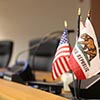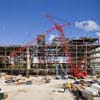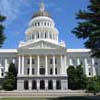California's Green Building Code Effective January 1, 2011

January 2011
Number 3
�
As we first reported in March 2010, California has adopted the nation's first mandatory green building code, also known as "CalGreen", which became effective January 1, 2011. (Cal. Code Regs., tit. 24, Part 11.) CalGreen applies to all new construction (but not modernizations), and contains measures applicable to K-12 schools and community colleges, which will be enforced by the Division of the State Architect ("DSA"). In 2011, some portions of CalGreen for new schools are mandatory and some are voluntary. For the first time, the voluntary standards include the goal that all new schools be "grid-neutral," meaning that a site must produce as much renewable energy as it consumes in a year. This goal will likely have far-reaching impacts as more schools are designed and constructed with built-in renewable energy features.
CalGreen addresses five major areas: (1) planning and design; (2) energy efficiency; (3) water efficiency; (4) material conservation and resource efficiency; and (5) indoor environmental quality. The CalGreen code can be found by clicking here.
Mandatory Requirements
Some highlights of the mandatory requirements contained in CalGreen are:
�In addition, the mandatory portion of CalGreen contains a provision that "encourages" at least a 15% reduction in energy usage compared to current energy efficiency standards. It is not clear how DSA will enforce this provision, as it does not appear to require an actual reduction in energy usage. However, districts would be wise to consider energy conservation measures - and even renewable energy features - in planning their new construction projects.
Some sources have reported that building commissioning - a quality assurance process for verifying that building systems are planned, designed, installed, operated, and maintained to meet project requirements - will become mandatory for new schools in 2011. While some nonresidential construction in the state will be subject to this requirement, this aspect of CalGreen has not been adopted by DSA, and is therefore not a mandatory requirement for schools at this time. However, building commissioning remains a voluntary standard that districts can elect to meet.
Voluntary Standards
CalGreen's voluntary standards are extensive, and it appears likely that as the code is revised in upcoming years, standards that are now voluntary may increasingly become mandatory. Because these standards are voluntary, school districts can elect whether to meet them when planning new projects now - whether such projects are new construction or modernizations.
Some of the voluntary standards include:
Grid Neutral
The voluntary standard that will likely have the farthest-reaching effect is the goal that schools be 35%, 75%, or 100% grid neutral. According to the new code, "A site that produces at least as much renewable electricity as it uses in a year shall be deemed grid neutral." More than any of the other changes in the green building code, the grid neutral goal looks to impact districts as they evaluate the structural, legal, and financial implications of installing photovoltaic solar panels and other sources of renewable electricity. DSA has stated a goal of reviewing all plans with an eye to achieving grid neutrality. (For more on grid neutrality from DSA, click here.)
As the law in this area evolves, there are certain to be questions regarding exactly how CalGreen will work in practice, where the boundaries will fall between mandatory and voluntary elements, and when in the future some voluntary measures may become mandatory.
For more on CalGreen, energy saving measures, and the legal and financial realities of installing solar energy systems, please do not hesitate to contact one of our eight offices located statewide or consult our website.
�
Ruth Mendyk
Shareholder and Facilities & Business Practice Group Co-Chair
Fresno Office
rmendyk@lozanosmith.com
�
Devon B. Lincoln
Associate
Monterey Office
dlincoln@lozanosmith.com
�
2011 Lozano Smith
Number 3
�
As we first reported in March 2010, California has adopted the nation's first mandatory green building code, also known as "CalGreen", which became effective January 1, 2011. (Cal. Code Regs., tit. 24, Part 11.) CalGreen applies to all new construction (but not modernizations), and contains measures applicable to K-12 schools and community colleges, which will be enforced by the Division of the State Architect ("DSA"). In 2011, some portions of CalGreen for new schools are mandatory and some are voluntary. For the first time, the voluntary standards include the goal that all new schools be "grid-neutral," meaning that a site must produce as much renewable energy as it consumes in a year. This goal will likely have far-reaching impacts as more schools are designed and constructed with built-in renewable energy features.
CalGreen addresses five major areas: (1) planning and design; (2) energy efficiency; (3) water efficiency; (4) material conservation and resource efficiency; and (5) indoor environmental quality. The CalGreen code can be found by clicking here.
Mandatory Requirements
Some highlights of the mandatory requirements contained in CalGreen are:
- �No direct-beam illumination should leave a site (except safety and emergency lighting)
- �New schools must achieve a 20% reduction in their use of potable water as compared to current standards
- �New schools must also reduce their wastewater by 20%, using such measures as installing water-conserving fixtures (e.g., toilets)
- �Districts must submit construction waste management plans to DSA
- �A minimum of 50% of construction and demolition debris must be recycled or salvaged; 100% of trees, stumps, rocks and associated vegetation and soils resulting from land clearing must be reused or recycled
- �Paints, carpets, composite wood components and 50% of resilient floorings must be low in VOCs (volatile organic compounds)
�In addition, the mandatory portion of CalGreen contains a provision that "encourages" at least a 15% reduction in energy usage compared to current energy efficiency standards. It is not clear how DSA will enforce this provision, as it does not appear to require an actual reduction in energy usage. However, districts would be wise to consider energy conservation measures - and even renewable energy features - in planning their new construction projects.
Some sources have reported that building commissioning - a quality assurance process for verifying that building systems are planned, designed, installed, operated, and maintained to meet project requirements - will become mandatory for new schools in 2011. While some nonresidential construction in the state will be subject to this requirement, this aspect of CalGreen has not been adopted by DSA, and is therefore not a mandatory requirement for schools at this time. However, building commissioning remains a voluntary standard that districts can elect to meet.
Voluntary Standards
CalGreen's voluntary standards are extensive, and it appears likely that as the code is revised in upcoming years, standards that are now voluntary may increasingly become mandatory. Because these standards are voluntary, school districts can elect whether to meet them when planning new projects now - whether such projects are new construction or modernizations.
Some of the voluntary standards include:
- Adding bike storage and changing areas
- Reducing on-site parking
- Orienting structures and adding vegetation to reduce thermal loss
- Reducing potable water use by 30%
- Providing water efficient landscape design
- Using construction materials with at least 10% recycled content value
- Recycling or salvaging 80% of construction or demolition debris
- Using life cycle assessment and, as noted above, building commissioning to review projects before and after construction
- Minimizing and isolating pollutants
- Providing individual lighting and heating controls for work stations and shared spaces like classrooms
- �
Grid Neutral
The voluntary standard that will likely have the farthest-reaching effect is the goal that schools be 35%, 75%, or 100% grid neutral. According to the new code, "A site that produces at least as much renewable electricity as it uses in a year shall be deemed grid neutral." More than any of the other changes in the green building code, the grid neutral goal looks to impact districts as they evaluate the structural, legal, and financial implications of installing photovoltaic solar panels and other sources of renewable electricity. DSA has stated a goal of reviewing all plans with an eye to achieving grid neutrality. (For more on grid neutrality from DSA, click here.)
As the law in this area evolves, there are certain to be questions regarding exactly how CalGreen will work in practice, where the boundaries will fall between mandatory and voluntary elements, and when in the future some voluntary measures may become mandatory.
For more on CalGreen, energy saving measures, and the legal and financial realities of installing solar energy systems, please do not hesitate to contact one of our eight offices located statewide or consult our website.
�
Ruth Mendyk
Shareholder and Facilities & Business Practice Group Co-Chair
Fresno Office
rmendyk@lozanosmith.com
�
Devon B. Lincoln
Associate
Monterey Office
dlincoln@lozanosmith.com
�
2011 Lozano Smith
As the information contained herein is necessarily general, its application to a particular set of facts and circumstances may vary. For this reason, this News Brief does not constitute legal advice. We recommend that you consult with your counsel prior to acting on the information contained herein.






